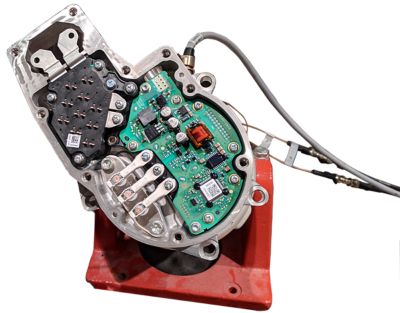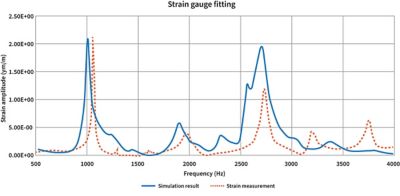ANSYS ADVANTAGE MAGAZINE
July 2021
Sanden Reduces Model Creation Time by 85%
By Bruno Gaudin, Senior Application Engineer, Ansys
The Sanden Group is a Tier 1 automotive supplier of air conditioning compressors based in Japan that has locations around the world. The Sanden European technical center has three locations, one of which is in France at Sanden Manufacturing Europe, where research & development, design and test activities are performed. The company has been an Ansys customer since 2008, using Ansys Mechanical, Ansys Fluent, Ansys Maxwell, Ansys Motor-CAD and more. Last year, Sanden Manufacturing Europe decided to test Ansys Sherlock automated design analysis software to analyze printed circuit boards (PCBs) for its electrical compressors
We caught up with Arnaud Menon, CAE expert, and Jérôme Le Gal, director of the Technical Center of France (TCF) at Sanden Manufacturing Europe to ask about the company’s experience with Sherlock and their future plans.
An electrical compressor PCB assembly mounted on its casing
Ansys Advantage: How are you using Sherlock?
Sanden: For each new compressor generation, we need to redesign a PCB. So, we start from zero, but we re-use our experience. Sherlock allows us to arrive at a robust design faster, with less trial-and-error iteration.
We analyze the PCB on the electrical compressors. There is one PCB per compressor but sometimes, due to design constraints, we have to split it into two parts. We simulate and, based on the results, we ask for the designers to fix any issue that may be revealed by the simulation analysis, such as adjusting the PCB thickness, attaching a component directly to the housing, changing a component’s position, etc. We try to combine everything together: the electronic, mechanical (static and vibrations analysis) and thermal requirements. This part of the job is very challenging.
“The data settings and the meshing job for the simulation is much faster than our previous workflow. We went from a week to a day to generate a first draft.”
Advantage: What features made you choose Sherlock?
Sanden: We chose it mainly for its database and the fatigue tools. Until we started using Sherlock, the correlation between tests and simulation was performed, but we did not have any criteria to see if a component would fail or not, so we had to only perform comparative analysis. Now, we can do more precise analysis with real criteria. For example, Sherlock give us the top three most critical components we have to monitor.
The data settings and the meshing job for the simulation is much faster than our previous workflow. We went from a week to a day to generate a first draft. Previously, we had to recreate a material for each component to have the right mass at a good location. Now, with Sherlock it is straightforward. Sherlock also creates a simple and good mesh directly, which was not the case before when we had the computer-aided design (CAD) file. It was more complicated. Sherlock allows us to test more things.
We have not yet tested the thermal aspect. For now, we use Fluent to perform thermal tests. We appreciate that we can perform different vibration analysis (harmonic vibration, power-spectral-density (PSD) analysis, natural frequencies, etc.).
Finally, the direct reading of the ODB++ files allow us to have a direct approach from the ECAD team to the CAD team, avoiding using software to “translate” the ECAD files into CAD files. The visualization of the PCB directly in Sherlock is a strong point. We can see the layers of the components, summaries, etc.
Advantage: Can you describe your product design and development workflow, and how Sherlock was integrated into it?
Sanden: At the beginning, it was used later in the process. We used Sherlock on products that already existed to make correlations, test Sherlock and have confidence in it. We had PCBs that we could test. This validation was successful.Now, we use it at the beginning of the development. The goal is to avoid future issues before the production of the PCB. On the last project, thanks to Sherlock, we avoided two or three things that would have been annoying for the rest of the project. We removed three vibrating modes from the frequency band associated to our project.
The first eigen-mode of the PCB
Advantage: How does Sherlock help you address your product design and development challenges?
Sanden: It helps us make the right decision on the validity of the PCBs and how to correct them, improve our product by changing the parameters, and find solutions — even before making a first prototype. It is very easy to iterate on a project, for example, to simulate different scenarios.
Strain gauge amplitude fitting measurement results (dotted red) vs. simulation results (blue)
Advantage: Can you provide some concrete examples of benefits Sherlock has provided, such as time or cost savings?
Sanden: For the creation of a simple model, we went from 7 days to 1 day, with an improvement in the quality of the model.
Now, we have criteria. We will refine them, but for a first approach, I use the Sherlock criteria. As a result, we also save time there. It allows us to avoid redesign, and we are more confident in our results and can make decisions more quickly.
For more information on Sanden Manufacturing Europe, visit sanden-europe.com.
现在就开始行动吧!
如果您面临工程方面的挑战,我们的团队将随时为您提供帮助。我们拥有丰富的经验并秉持创新承诺,期待与您联系。让我们携手合作,将您的工程挑战转化为价值增长和成功的机遇。欢迎立即联系我们进行交流。


